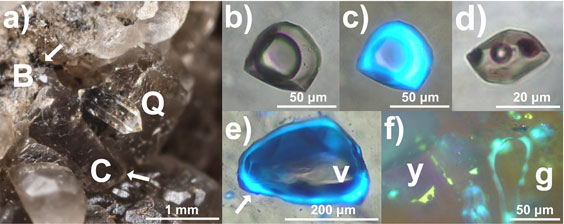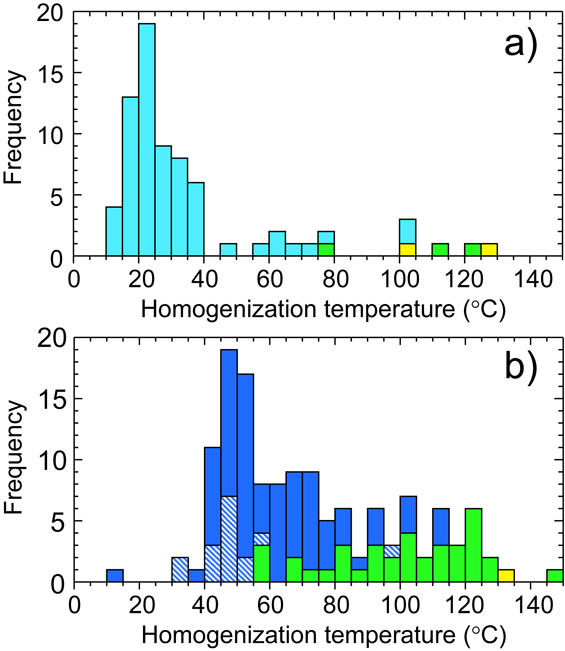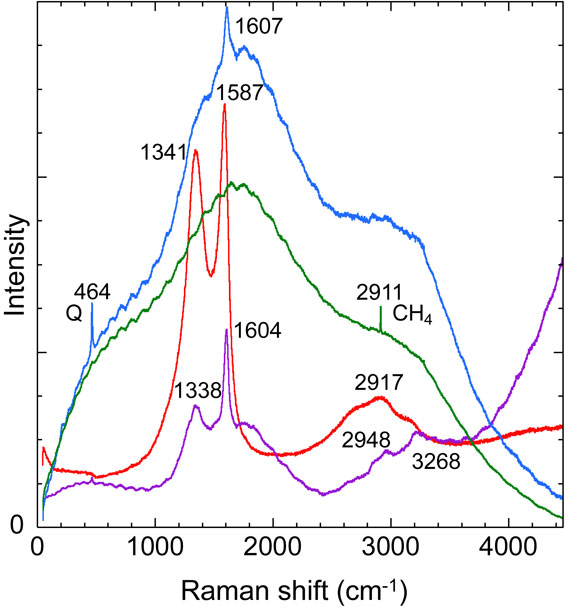2023 年 118 巻 1 号 論文ID: 220910
2023 年 118 巻 1 号 論文ID: 220910
Hydrocarbon fluid inclusions in authigenic quartz from the Jurassic Torinosu Limestone and associated sediment at Sakawa town, Japan, were studied by microthermometry, ultraviolet (UV) fluorescence, and Raman spectroscopy. The quartz contained abundant liquid hydrocarbon and subordinate vapor hydrocarbon fluid inclusions, and tiny solid inclusions of bitumen, calcite, and rarely pyrite. Aqueous fluid inclusions and aqueous components in hydrocarbon inclusions were absent. Under UV irradiation, most of the liquid inclusions from the limestone and associated sediment displayed intense whitish-blue and deep-blue luminescence, respectively. Further, these liquid inclusions were homogenized at around 24 °C and 53 °C, respectively. Small numbers of liquid inclusions from the associated sediments contained a liquefied gas-condensate. Raman measurements indicated the presence of aromatic compounds and the absence of H2O or CO2 molecules in the liquid and vapor inclusions.
Fluid inclusions are small volumes of paleofluid trapped in minerals and the only direct evidence of the role of the fluid in various geological processes at igneous, metamorphic, sedimentary, and extraterrestrial environments (Roedder, 1984). They can provide information on the physical and chemical nature of geofluids during mineral growth, as well as the later fluid history of the system (Roedder, 1984). Fluid inclusions in sedimentary rocks from oil fields often trap biogenic hydrocarbon fluids and are called hydrocarbon or petroleum fluid inclusions (Roedder, 1984; McLimans, 1987; Bodnar, 1990; Guilhaumou et al., 1990). Hydrocarbon fluid inclusions are small droplets, usually <10 µm in diameter, of pore fluid trapped during crystallization of minerals such as quartz, calcite, feldspar, and fluorite in sedimentary rocks from oil fields and their surrounding areas (Roedder, 1984; Bodnar, 1990; George et al., 2007). These droplets also contain complex mixtures of mainly organic compounds (low carbon-number gases, paraffins, naphthalenes, aromatics, resins, and sometimes waxes) originating from petroleum that migrated through source rocks (Munz, 2001; George et al., 2007; Suchý et al., 2010). Thus, these inclusions reveal the mineral diagenesis and petroleum generation and migration in sedimentary basins (Bodnar, 1990; Munz, 2001; George et al., 2007). The most valuable attribute of hydrocarbon inclusions is fluorescence color under ultraviolet (UV) illumination (George et al., 2007; Bourdet et al., 2012). The observed variability of the fluorescence color primarily depends on the concentrations of aromatic and polyaromatic hydrocarbons as fluorophores (Hagemann and Hollerbach, 1986; Stasiuk and Snowdon, 1997; Ryder, 2005).
Most hydrocarbon inclusion studies have been performed on petroliferous sediments and associated rocks from continental areas. Few such studies have been performed in the Japanese islands, except on quartz crystals in fissures from Neogene sedimentary rocks of the Niigata oil and gas fields (e.g., Okubo, 1998). Fluorescent hydrocarbon inclusions, however, have been reported in authigenic quartz from organic-rich Mesozoic limestone (that is not from an oil field) in Kochi Prefecture, southwest Japan (Minakawa, 1996). The occurrences and physical properties of the inclusions may provide insights into about the chemistry and behavior of hydrocarbon fluids originating from calcareous sediment formed in a shallow-marine setting in the western Paleo-Pacific (Ohga et al., 2013). In this paper, we performed basic and detailed descriptions, microthermometry, and micro-Raman spectroscopic measurements of the inclusions to reveal features of the geofluids in such a geological setting.
Authigenic quartz crystals were collected from the Torinosu Limestone at Eastern Hitotsubuchi Quarry, Sakawa town, Kochi Prefecture, Japan, and from alluvial sediment in farmland near the quarry at Kawarada village (Fig. 1).

The Torinosu Limestone consists of shallow-marine carbonate mounds within the Upper Jurassic to Lower Cretaceous upper unit of the Torinosu Group. The upper unit comprises mudstone and sandstone with lenticular dark gray limestone bodies containing abundant fossils (Kano, 1988; Ohga et al., 2013). The limestones also contain tiny droplets of petroleum in cavities, fissures, and calcite veins (Takahashi and Yamanouchi, 1922). Further, it contains authigenic crystals of calcite, dolomite, quartz, fluorite, celestine, barite, and strontianite, and particles of bitumen (Minakawa, 1996). The limestone is rich in hydrocarbons with carbon numbers of 1-5 (C1-C5) and organic and elementary carbon. The C1-C5 hydrocarbon amount is several times higher than those in Japan’s Silurian to Quaternary limestones (Fujinuki et al., 1971). Moreover, the limestone showed oil seepage, bitumen patches, and very tiny framboidal pyrite. The studied quartz samples coexisted with calcite crystals and bitumen in small cavities in the dark gray massive limestone (Fig. 2a). The quartz was colorless, transparent, euhedral crystal with double termination and relatively flat shape, several to ten millimeters long.

The Kawarada locality is situated in low-lying land between the upper unit (which includes the Torinosu Limestone) and the lower unit of the Torinosu Group (Kano, 1988; Ohga et al., 2013). The sediment from Kawarada consisted mainly of mud and sandstone fragments and small amounts of doubly-terminated euhedral quartz crystals. These crystals were approximately 10 mm long, colorless, pale smoky, or milky in color, and contained many fluorescent fluid inclusions and bitumen particles.
Ten quartz samples were cut into slices (ca. 200 µm thick) and doubly polished. Fluorescence colors of inclusions were observed under a polarizing microscope equipped with UV illumination (365 nm). Microthermometric measurements were performed using a Linkam LK1500 heating-freezing stage (Linkam, Tadworth, UK) with an optical microscope. Typically, no significant phase transitions were observed during freezing (cf. Hurai et al., 2015). Thus, only the final homogenization temperature (Th) was measured. Fluid inclusions were heated to Th at 2 °C/min. The temperature was calibrated using the melting point (114.34 °C) of acetanilide (a certified reference material, Laboratory of the Government Chemist, UK), with a precision of ±0.5 °C at 114 °C. Hydrocarbon speciation of inclusion fluids and bitumen was identified with a confocal InVia Raman spectrometer (Renishaw, Wotton-under-Edge, UK). The measurements were performed at room temperature using a 532 nm (green) laser focused through a 100× microscope objective. The spatial resolution of the laser is approximately 1 µm. The samples were scanned from 50 to 4600 cm−1 wavenumber shift at a spectral resolution of 4 cm−1. Solid inclusions in quartz samples and authigenic minerals in the limestone were analyzed using a JSM-6010LA scanning electron microscope (JEOL, Tokyo, Japan) at 20 keV accelerating voltage.
The quartz samples from the Torinosu Limestone contained abundant liquid fluid inclusions, subordinate vapor fluid inclusions, and solid inclusions of small amounts of colorless euhedral calcite crystals and rarely metallic pyrite. Further, solid inclusions of trace amounts of blackish-brown bitumen were also observed.
Liquid and vapor inclusions in quartz from the Torinosu Limestone were distributed randomly across the crystal. The inclusions were a few tens to several hundred micrometers in size. The inclusion shapes varied from negative crystals to lenticular ones, while the larger-sized inclusions were irregularly shaped. They occurred as clusters or isolated inclusions suggestive of a primary origin. Clusters of only liquid inclusions and vapor inclusions were also identified. Some inclusions were arranged in trails, probably representing pseudosecondary inclusions originating from cracks induced during crystal growth. Such cracks are considered to be generated by a large density of lattice defects caused by rapid crystal growth, solid inclusions, and large amounts of impurities during growth (Audétat and Günther, 1999). In addition, a few secondary inclusions along a partially-healed crack were observed.
Primary and pseudosecondary liquid inclusions in the Torinosu quartz contained a hydrocarbon that was slightly brown to yellowish-brown or colorless. Most of the inclusions contained bubbles (approximately 2%-20% by volume) (Fig. 2b, c), although 40% of the liquid inclusions exhibited no bubble at room temperature. Upon cooling, a tiny bubble appeared inside the apparent non-bubble inclusion at temperatures less than 15 °C. Small precipitates of blackish-brown bitumen were rarely observed in liquid inclusions (Fig. 2d). Such precipitates are thought to be asphaltenes (heavy-oil fraction) formed by a decrease in temperature and pressure or dissolved CO2 in hydrocarbon fluids (Guilhaumou et al., 1990). Liquid inclusions with a visible aqueous phase (bubble-hydrocarbon liquid-aqueous liquid) were absent in the quartz, and Raman measurements showed no aqueous liquid inclusions.
The liquid and vapor inclusion distributions in quartz samples from Kawarada were similar to those of the Torinosu samples. Primary and pseudosecondary liquid inclusions in the Kawarada samples contained hydrocarbon that was slightly brown to yellowish-brown or colorless, and all the inclusions contained bubbles (approximately 15%-40% by volume). Some quartz samples comprised many liquid inclusions containing bitumen precipitate. However, hydrocarbon inclusions with a visible aqueous phase and aqueous liquid inclusions were absent.
Vapor inclusions in the quartz from Kawarada were dominated by large vapor bubbles (approximately 90 vol %). These inclusions exhibited fluorescence of thin liquid hydrocarbon films along the inclusion wall (Fig. 2e). However, the precipitates of bitumen were absent.
UV fluorescenceThe hydrocarbon inclusions from both localities mostly showed strong luminescence at 365 nm UV illumination. The fluorescence color of hydrocarbon fluid inclusions is controlled by the composition and maturity (degree of thermal cracking) of hydrocarbons (Hagemann and Hollerbach, 1986; Bodnar, 1990; Stasiuk and Snowdon, 1997) or compositional fractionation of oil during its trapping process (George et al., 2007). With increasing oil maturation, the fluorescence color changes gradually from red to orange, followed by yellow, green, deep blue, whitish-blue, and white (Bodnar, 1990; Hurai et al., 2015). The color change reflects an increase in the proportion of low-molecular-weight hydrocarbons (Hagemann and Hollerbach, 1986; Stasiuk and Snowdon, 1997).
Almost all the liquid and vapor inclusions in quartz from the Torinosu Limestone exhibited a whitish-blue fluorescence color (Fig. 2c), which indicates a highly mature composition. The same quartz showed green and yellow-fluorescing inclusions for less than 7% of all the liquid inclusions (Fig. 2f). However, deep-blue-fluorescing inclusions were not observed. Bubbles and bitumen precipitates in the liquid inclusions from both localities were non-fluorescent. The calcite, and seeped oil in sampled limestones exhibited the same strong whitish-blue luminescence as the quartz under 254 and 365 nm UV illuminations.
The quartz from Kawarada showed large numbers of deep-blue-fluorescing liquid inclusions and less than 25% green-fluorescing liquid inclusions. While yellow-fluorescing inclusions were rare, whitish-blue-fluorescing inclusions were absent. Similarly, colorless liquid hydrocarbon inclusions without visible fluorescence were rarely observed in the quartz. Few Raman bands were observed corresponding to these inclusions due to the presence of aromatic compounds. In contrast, no Raman peak was observed for the H2O molecules. Most vapor inclusions from Kawarada displayed deep-blue fluorescence (Fig. 2e). However, the collected mud and sandstone fragments were not fluorescent.
Homogenization temperatureThe primary and pseudosecondary liquid inclusions from the Torinosu Limestone were homogenized to the liquid phase at 11 °C -129 °C, with a peak at 25 °C (n = 73) (Fig. 3a). Mainly, the whitish-blue fluorescing inclusions were homogenized at a peak temperature of about 24 °C (n = 68), whereas the green- and yellow-fluorescing inclusions were homogenized at 76 °C -129 °C (n = 5).

The primary and pseudosecondary liquid inclusions in the Kawarada samples were mostly homogenized to the liquid phase, whereas less than 12% of the liquid inclusions were homogenized to the vapor phase. In this paper, we call the former Type A and the latter Type B inclusions. Inclusion fluids in Type A and Type B inclusions were volatile oil and liquefied gas condensate, respectively (Munz, 2001). Type B liquid and vapor inclusions in the Kawarada samples suggest multiple episodes or simultaneous trapping of various gas-condensates in the quartz.
Mainly Type A inclusions from Kawarada exhibited deep-blue fluorescence. Less than 30% of the Type A inclusions were green-fluorescent. The deep-blue-fluorescing inclusions were homogenized at 14 °C -110 °C with a peak at 53 °C (n = 81) (Fig. 3b). The green- and yellow-fluorescing inclusions exhibited Th higher than 80 °C (n = 38). All the Type B inclusions were deep-blue-fluorescent and showed nearly the same Th range (33 °C -97 °C, with a peak at 48 °C; n = 16) as those of Type A. Liquid inclusions similar to Type A and Type B have been reported in the authigenic quartz in the core cuttings of Miocene strata of the Niigata oilfield, Niigata Prefecture, Japan (Okubo, 1998).
Raman spectraHeavy oil components such as aromatics in the inclusions were compared with the Raman spectra of bitumen. Bitumen from the cavities in the Torinosu Limestone showed typical bands with principal peaks at around 1360 and 1600 cm−1 (Fig. 4), corresponding to C-C stretching in aromatic rings (Zhang et al., 2007; Hurai et al., 2015). These bands are red-shifted with increasing bitumen maturity (Hurai et al., 2015). Additional weak bands between 2970 and 3200 cm−1 are assigned to methyl and methylene groups (Zhang et al., 2007). The bitumen precipitates in liquid inclusions from both localities showed the same bands as the bitumen from the cavities (Fig. 4). Liquid inclusions with no visible or very weak fluorescence from both localities also demonstrated the typical bitumen band at around 1600 cm−1 (Fig. 4). This indicates the presence of aromatic hydrocarbons in the fluids. However, for the liquid and vapor inclusions, Raman bands of H2O and CO2 molecules were absent in hydrocarbon fluids. Further, no significant Raman peaks were observed for the bubbles in liquid and vapor inclusions, although a methane band (2910 cm−1; Hurai et al., 2015) was occasionally detected in bubbles (Fig. 4).

The present observations revealed that authigenic quartz crystals from the Torinosu Limestone and Kawarada comprised abundant liquid and vapor inclusions of hydrocarbon. Both inclusions in the same crystals imply multiple stages of entrapment or simultaneous trapping of volatile oil and gas condensate (McCain, 1994) separated from an original hydrocarbon source during crystallization. The liquefied gas-condensate was also observed in the Kawarada samples. The absence of aqueous fluids in the quartz from both localities indicates the separation of hydrocarbon fluids from hydrocarbon-water mixtures in calcareous sediments. Such phase separation is attributed to the decrease in pressure and temperature (McLimans, 1987).
Most liquid inclusions in quartz from the Torinosu Limestone and Kawarada exhibited whitish-blue and deep-blue fluorescence colors, respectively. This color suggests mainly light to medium oil hydrocarbon in the inclusions (Hurai et al., 2015). Green- and yellow-fluorescing inclusions were also observed in quartz from both localities. Various fluorescence colors (blue, green, and yellow) of hydrocarbon inclusions in the same crystals were often reported. The mixed fluorescence responses can be interpreted as multiple charging events (Guilhaumou et al., 1990) due to alteration of fluid inclusions during sample preparation (Stasiuk and Snowdon, 1997) or compositional variations resulting from progressive entrapment of oils at evolving maturity and/or fractionation while trapping (Blanchet et al., 2003). Because only a few green- and yellow-fluorescing inclusions were present in the studied quartz, the fluorescence variation may have been caused by a slight change in the composition and/or concentration of the inclusion fluids during the trapping process.
The Th of liquid inclusions from both localities (approximately 10 °C -140 °C) were significantly lower than the paleo-temperature (245 °C-260 °C) estimated for the Jurassic Chichibu belt which includes the Torinosu Group (Suzuki et al., 2013). The paleo-temperature was estimated based on corrected vitrinite reflectance values of carbonaceous materials in mudstones from Kochi Prefecture (Suzuki et al., 2013). Typically, the Th of hydrocarbon inclusions exhibits a positive relationship with maturity and negatively correlates with the paleo-temperatures of the inclusion-bearing host rocks (Okubo, 1998). Heating experiments of synthetic hydrocarbon inclusions at 250 °C for 30 days revealed that resin amounts in hydrocarbon increased by the thermal decomposition of asphaltene in the hydrocarbon (Teìnturìer et al., 2003). Upon heating at 370 °C for 8 days, the original Th of natural hydrocarbon inclusions was reduced by 21 °C (Okubo, 1998). Thus, the low Th of the present liquid inclusions could be attributed to the progress of maturity of the hydrocarbon fluids. The higher Th for the green-, yellow-, and deep-blue-fluorescing inclusions than for the whitish-blue-fluorescing inclusions was also consistent with the degree of maturity.
The peak temperatures (53 °C and 103 °C) of the Type A liquid inclusions from Kawarada were higher than those (25 °C and 65 °C) from the Torinosu Limestone. Assuming the same original hydrocarbon source, the difference in the peak temperatures implies that hydrocarbon fluids in the inclusions from Kawarada were relatively less mature than those from the Torinosu Limestone. The low maturity is consistent with the fluorescence color and high abundance of liquid inclusions bearing bitumen precipitates from Kawarada.
Hydrocarbon fluid inclusions in authigenic quartz from the Torinosu Limestone and associated sediment at Sakawa town, Kochi Prefecture, were investigated to elucidate chemical features of hydrocarbon fluids from regions besides Japan’s oil fields. The quartz crystals from both localities exhibited abundant liquid and vapor hydrocarbon inclusions, considered as the volatile oil and gas condensate separated from the original hydrocarbon source during crystallization, respectively. The volatile oil was light to medium with small amounts of asphaltenes. Since aqueous fluid inclusions and aqueous components in the hydrocarbon inclusions were absent in the quartz, the inclusion fluids probably originated from hydrocarbon components separated from hydrocarbon-water mixtures in calcareous sediments.
The authors thank Mr. K. Miyashita of Susaki Kohatsu Co., Ltd. and Mr. M. Kataoka of Sakawa town for their permission to survey and conduct sampling. This study was partly supported by the Japan Society for the Promotion of Science Grant-in-Aid for Scientific Research (no. 18H05447 to M. K.). This work was also supported by the Cross-ministerial Strategic Innovation Promotion Program, “Next-generation technology for ocean resources exploration (Zipangu in the Ocean).” The authors would also like to thank two anonymous reviewers and the journal editor, Dr. K. Shinoda, for their useful comments that helped us revise this manuscript.